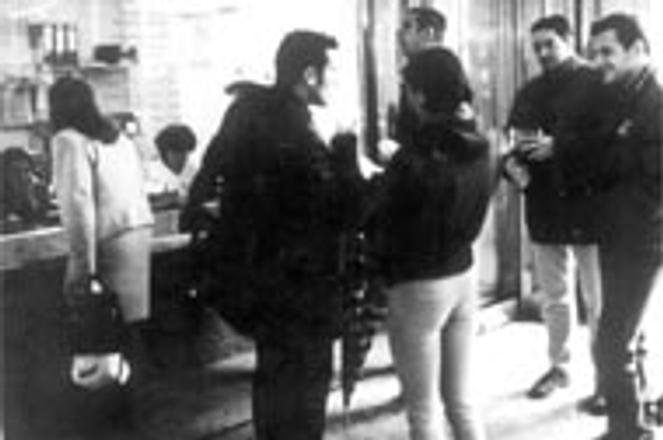Getting nervous. Slovak citizens line up to exchange crowns for hard currencies after Oct. 1.SME
The National Bank of Slovakia (NBS) shocked financial markets on October 1 by abolishing the fluctuation band of the Slovak crown and cancelling its fixed regime, which had been pegged to a mark/dollar currency basket.
While capital markets have long been saying that the crown was overvalued and predicting that the central bank would widen the fluctuation band to let the currency weaken, the complete abolition of the fixed regime came as a big surprise.
At a hastily called briefing, central bank Governor Vladimír Masár cited the devaluation expectations of citizens and the corporate sector, downgradings of Slovakia' credit ratings and problems in refinancing the state budget deficit as the main reasons behind the decision to float the currency.
"The national bank will no longer guarantee a fixed exchange rate of the crown. The crown's exchange rates will now be determined by supply and demand on the market," Masár said in explanation of the move.
He also said the NBS had spent "almost $1 billion" in supporting the crown since the beginning of August. The bank's official hard currency reserves totalled $2.9 billion as of October1. Masár said that this covered the equivalent of 2.4 months of imports, while the central bank has repeatedly said that a stable level for Slovak economy was at least three months of imports.
The Slovak crown has been under strong pressure in the past few months after domestic corporate subjects started to buy large amounts of hard currencies in order to hedge their foreign loan payments in expectation of devaluation. The central bank repeatedly intervened through its daily fixing to support the crown by fixing it above market levels.
The crown had been trading close to the weaker edge of its former plus/minus 7.0% fluctuation band over the past few weeks. Vice-governor Marian Jusko said on October 2 that the float would be managed by the central bank and that the bank would intervene to prop up the currency if it "develops in a different direction than the NBS wants to see."
Jusko also said that the central bank would now follow the crown's movements mainly against the German mark, since the mark will be the strongest currency in the European Monetary Union and because the major part of Slovakia's foreign payments are made in German currency.
Reactions to the crown's floating varied widely. While the vast majority of currency traders and analysts welcomed the move as a necessary step for the stabilisation of macroeconomic development, some politicians criticised the NBS for the bad timing of the flotation.
"It was the best possible thing they could have done at this time. The pressure (on the currency) had become unbearable," said Rastislav Živor, a trader at ING Barings. On the other hand, an economic expert from the opposition Party of the Democratic Left (SDĽ), Brigita Schmögnerová, was for once in step with deputy Premier Sergej Kozlík in blasting the central bank for the move.
Schmögnerová said that the step could spark an inflationary spiral, lead to a sharp crown depreciation and in the end not necessarily help curb the country's burgeoning current account deficit. She argued that the high dependency of exports on imports may be an obstacle for a major improvement in the trade balance. Analysts estimate that one crown (100 hallers) of Slovak exports need around 70 hallers of imports.
Kozlík said the central bank's timing was poor since it had floated the currency at a time when "the country was experiencing an improvement in its trade balance." He also said that the central bank "appeared to have given in to politial pressure" resulting from September's general elections. Central bank officials have strictly rejected any political factors behind the move, arguing that it was motivated purely by economic factors.
The Slovak crown fell sharply against world currencies immediately after the central bank announced the flotation and despite the fact that the announcement came after the close of official trading on the local interbank market.
Principally foreign banks were buying hard curencies against the crown which pushed the Slovak currency to as low as 20% below the central parity of former basket. The 10% decline meant a move to aound 36 to 38 crowns per dollar and to 22 to 24 crowns per German mark in first days of trading after the flotation.
Vice-governor Jusko said the crown's initial fall was not dramatic and that its movements were acceptable. He added that reserves of $2.9 billion were sufficient to defend the currency, but said that some unspecified foreign banks had promised to help the Slovak central bank if it needed to boost reserves.
Future movements of the crown will depend mainly on how quickly the new government will be formed and how long it lasts. "Foreign investors are waiting to see signs of a stable goverment that can last for a four year-term. A stable government, a restrictive fisal policy and tight monetary policy - these are the things that can hep the crown and eventually push it along the Czech path," said a foreign exchange dealer at one foreign bank.
He was referring to the situation that occured in the Czech Republic when the Czech crown fell sharply after it was floated in June 1997, but was resuscitated to its current record highs by austerity measures.
However, until the new Slovak government presents a tough economic programme and until foreign investors show renewed confidence in the Slovak currency, the crown will stay highly volatile, moving between 12 and 22% below the midpoint of the former basket. The crown's range against the mark is expected to be between 21 and 24%.


